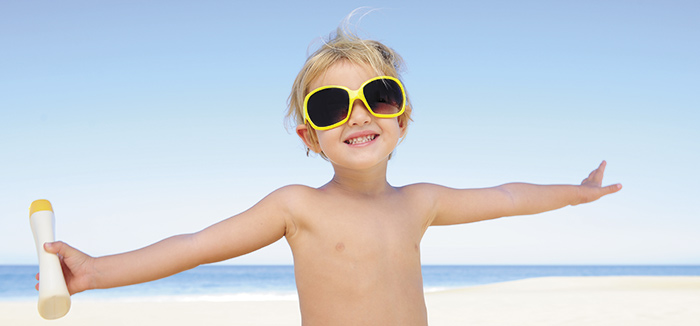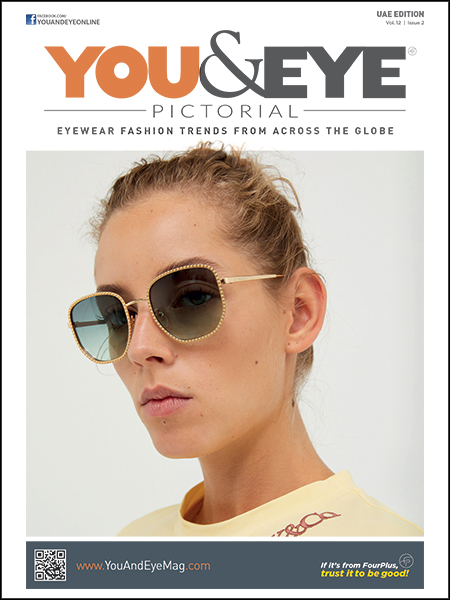 Kids spend more time outdoors than adults do and they are exposed to UV a whole lot more. And the sooner you get them to wearing sunglasses, the better it is for their long term eye health..
Kids spend more time outdoors than adults do and they are exposed to UV a whole lot more. And the sooner you get them to wearing sunglasses, the better it is for their long term eye health..
It was In 1981 that Australia ran the ‘Slip-Slop-Slap’ health campaign that recommended the use of protective clothing and sunscreen before people ventured in the sun. It meant ‘Slip on a shirt, Slop on sunscreen and Slap on a hat’. Later, it was extended to include ‘Wrap-on some sunnies [sunglasses]’ and schools there have been following it religiously.
Well, the Aussies realised that children need sunglasses, as much as adults – especially kids who spend longer periods at the beach or playground, in fact, any place outdoors. And here in the Middle East, the sun is not really easy on the eyes and this fact is surely respected by the adults. However, when it comes to their kids, most parents do not seem to understand the importance of protection from the sun for skin as well as vision.
KIDS AND THEIR EYES
 Kids are more prone to the damaging effect of the sun’s rays. This may sound surprising to the uninitiated but it’s true. In fact, the first ten years of any human life, the lens of the eye is most transparent. At birth, the lens of the human eye is almost 95 percent transparent and at around 6 months it is 80 percent transparent and it reduces to 75 percent by the 8th year. As the crystalline lens gradually loses transparency and begins to yellow, the amount of ultraviolet (UV) rays penetrating the lens decreases.
Kids are more prone to the damaging effect of the sun’s rays. This may sound surprising to the uninitiated but it’s true. In fact, the first ten years of any human life, the lens of the eye is most transparent. At birth, the lens of the human eye is almost 95 percent transparent and at around 6 months it is 80 percent transparent and it reduces to 75 percent by the 8th year. As the crystalline lens gradually loses transparency and begins to yellow, the amount of ultraviolet (UV) rays penetrating the lens decreases.
This statistic would make you aware of the vulnerability of the eyesight of kids below 10 to UV exposure. And it’s not just UV rays that are bad for eyesight. Even blue and blue-violet light, which are part of the spectrum of visible light, are damaging to the eye, especially when combined with UV rays.
KIDS WILL BE KIDS…
Protection from UV aside, the sunglasses they wear needs to be impact resistance as well. In this case choosing the right lens material is a very important step. And this is where an optometrist will be able to guide you to choose the right material. Generally materials like polycarbonate and Trivex are strongly recommended for little ones because of their superior impact resistance properties.
In addition to this, you can check with your optometrist about polarized lenses too. Polarised lenses reduce reflected glare which means reduced eyestrain and more visual comfort. For those kids who already wear prescription eyewear, photochromic lenses are a good option as normally kids do not switch their eyewear from indoor to outdoor, unless told. Since photochromic lenses automatically adjust in proportion to the intensity of the light, they are an excellent choice for children.
LENS COLOURS FOR KIDS
 Sunglass tints play a big role in vision care. Gray and brown are the popular colours and they have their own advantages. Gray lenses offer a more natural colour rendition and an even colour rendition throughout the visual spectrum. Gray-gray or gray-green lens tints also have an UV absorptive value of 70 per cent.
Sunglass tints play a big role in vision care. Gray and brown are the popular colours and they have their own advantages. Gray lenses offer a more natural colour rendition and an even colour rendition throughout the visual spectrum. Gray-gray or gray-green lens tints also have an UV absorptive value of 70 per cent.
Brown lenses reduce the effect of blue light, usually found in digital gadgets, and which can lead to the formation of cataracts. Check out our boxed text to get a clearer idea of what to look for while shopping for kids eyewear.
So the next time you are shopping for eyewear, give the kids sunglasses range a once-over too, especially if your child does not have one already!
________________________________________________________________
PICKING SUNWEAR FOR KIDS
The sunglass should make one third of the child’s face visible above the upper wire, and one third of the face visible below the sunglass. Its width should be as wide as the widest part of the face while ensuring that the upper eye wire provides sufficient coverage to block glare and sunlight.
Preschool (3-6 years): At this age the child’s nose has more depth. The frame should be as wide as the widest part of the face and should allow for at least one year’s growth. The bridge shape should distribute the eyewear’s weight evenly over the sides and the top of the child’s nose.
School Age (7-9 years): As kids grow, they become fussy about their eyewear colours and brands. It requires a lot of patience to handle their curiosity and demands, whether it is about designs, models or brands – and the viability of these!
Teens (10-14 years): By this age, kids have fully developed facial features and visual systems. But they like to be treated as adults and can be opinionated about their choices. They are inclined towards colours and brands that their peers or role models sport.
From the age of 10, the child’s nose has more cosmetic importance. It is the appearance of the frame’s bridge that may determine whether or not the child uses the sunglass. One has to be careful about taking care of this aspect and providing a bridge that fits the nose and is proportionate in appearance. Also, the child’s brow line and facial shape have to be considered.







